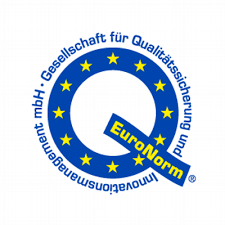LaReX
Laboratory reflectometer for the soft X-ray area
Project funding
Program
EuroNorm GmbH

INNO-KOM

Duration
Start : 01.09.2019
End: 31.01.2022
Project goal
The aim of this project is the industrial development of a laboratory (table top) reflectometer for the soft X-ray range, to include optical elements such as mirrors, multilayer mirrors, mono- and polycapillary lenses, various grating types up to the latest generation of 2D VLS gratings (RZP) on curved substrates and to determine their performance characteristics.
Description
X-rays, both soft and hard, are already being used to produce nanostructures (microelectronics) and to study inorganic and complex organic matter. For the development of new materials and functional materials, the structural, dynamic and functional relationships at the atomic level must be examined and understood if the technology is to be used specifically for the design and manufacture of optical components in the future. In particular, the areas of condensed matter and life sciences have been provided with new “tools” for investigation by the technological developments in recent years in the field of soft X-rays. The provision of the next generation of high-brilliance X-ray light sources, such as free electron lasers (FEL) or linear accelerators with energy recovery (ERL), have essentially contributed to this development. At the same time, however, compact laboratory X-ray sources such as high harmonics (HHG) or laser-generated plasma sources (LPP) were developed, which were able to establish themselves as a supplement to large-scale devices due to their flexibility and broad applicability. The disadvantage, however, is that these laboratory sources emit an X-ray photon flux that is several orders of magnitude lower than that of synchrotron or FEL sources. Laboratory X-ray sources can be used for spatially and time-resolved structural investigations and are particularly well suited for “pump-probe” experiments, for example, where the pulsed driver laser can be synchronized with the X-ray pulse in a relatively simple way (jitter). Essential applications are XAS (X-ray absorption), XES (X-ray emission), RIXS (resonant inelastic X-ray scattering), XRF (fluorescence), XRD (diffraction) or PES (photoelectron spectroscopy). However, these sources are currently only being developed further at research institutions; there is a lack of commercial sources. In the field of soft X-ray technology, there is also a lack of efficient, high-resolution optics and spectrometers, which makes further progress significantly more difficult. The wavelength in the soft X-ray range extends from approx. 250 pm (~ 5 keV) to 120 nm (~ 10 eV). In addition, the absorption cross section is particularly high in this energy range, which means that this technology can only be implemented in a vacuum. These conditions and the aforementioned weak X-ray photon flow from the laboratory sources require the highest precision and new manufacturing techniques from the manufacturing technology for highly efficient optical elements, which is currently reaching the limits of what is technically feasible. New innovative developments in this area are therefore to be expected here in order to be able to satisfy the needs and demands. An essential aspect here is quality assurance; without an efficient, inexpensive, time-saving and manageable technology, there can be no commercial advances in this field and thus no new, highly efficient and inexpensive optical elements can be developed and offered. Currently, the measurements for the development of optical elements and their quality control are mainly carried out on large devices. High costs are incurred for the provision of beam times and considerable administrative effort is required. Since there is a lack of alternatives to the large devices, a commercial laboratory device for the metrological investigations and characterization of optical elements would have a unique selling point. This laboratory device is not to be understood as a substitute, but rather as a sensible and necessary addition to the large-scale systems, since those devices will not come close to the quality and brilliance of a synchrotron or FEL, but can be used for most quality tests and for research and development work .
